
"Rutengang (taking the rod) "
Performance Installation 2019 - Presented within the framework of the event: Via Nova Kunstfest Corvey Long ago, far away _ the Heliand , Corvey Castle 31.August - 29. September 2019, Curated by Brigitte Labs_Ehlert Premiere Performance : 31.8.2020 Installation 31.August - 12. September 2019
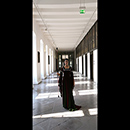 |
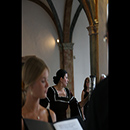 |
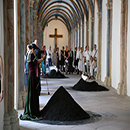 |
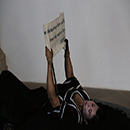 |
|||||
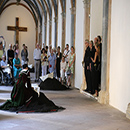 |
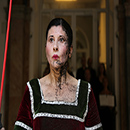 |
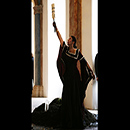 |
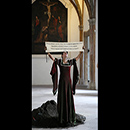 |
|||||
![]()
The focus of this year's art festival, Via Nova Kunstfest Corvey 2019 held under the motto “Long Ago – Far Away”, is the Old German biblical poem Heliand, which was written in Corvey around the year 850 and spread from there. In her performance and installation “Rutengang”, Nezaket Ekici constructs an art piece with particular reference to this poem.
Heliand was written to make Christianity comprehensible to forcibly baptized Saxons. In order to do so, the story of Jesus was adapted into a form the Saxons could understand and identify with: key features of the poem include its use of alliterative verse (stave rhyme) and the transformation of the story of Jesus and his disciples into a narrative shaped by the Saxon worldview.
Heliand attempts to build a bridge between the Saxons’ world—marked by warfare, closeness to nature, and polytheistic beliefs—and the culturally foreign ethics of Christianity, especially the ideal of loving one's enemies as expressed in the Sermon on the Mount.
In a synthesis of religious and cultural epistemologies, Ekici creates performance which intertwines the stave rhyme and the transformation of a cultural value system. Using a vibrating staff reminiscent of a dowsing rod, she evokes the Saxons’ archaic natural beliefs. The staff can also be interpreted as a weapon or a bishop’s crook, symbolizing the intersection of violence, spirituality, and authority. Furthermore, it’s relation to the shape and image of a ‘sceptre’ combined with the religious location of Ekici’s performance, suggests an almost priest-like undertaking. She is not only wielding a tool of man, but an instrument of God.
In her performance, the artist searches for the “linguistic treasures” of Heliand in specially constructed mounds of earth. With the support of a choir, these words are brought to life and made audible. Visitors are invited to read ten selected texts from Heliand while walking through the cloister.
Ekici draws attention to the origins of writing itself, noting that the word “letter” comes from nature—the earliest characters were carved from small wooden sticks, usually beech. The existential search for man’s relation to God is re-excavated through a return to both nature and history. By going back to the fundamental methods of language in carved wood, Ekici investigates whether or not our spiritual enterprise is one consisted in nature itself as God’s creation, or an invention of humanity to address nihilism and a lack of meaning. She continues by reading from the Heliand, a poem which is now over a thousand years old. And yet, none of the verses have lost any of their relevance to modern ethical values—on the contrary, they remain strikingly current. (Text Edited: Jono Wang Chu)
![]()
Flexible, 10 heaps of earth, 10 Heliand writing banners written on textile fabric, costumes,
Choir :Singers
![]()
1,5 h
![]()
Camera and editing : Branka Pavlovic
Photos: Andreas Dammertz
Singer: Hans-Hermann Jansen
Choir: Falkenberg church choir
Choir direction: Svenja Rissiek
Technical advisor: Michael Funk, Ernst Ehlert
Technical assistance: Sabine Fischer
Costumes design: Nezaket Ekici
Schneider: Süleymann
Helpers: Steffen Schneider, Matthias Knops
Press: Cornelia Jentzsch
Nezaket Ekici thanks Viktor Duke of Ratibor